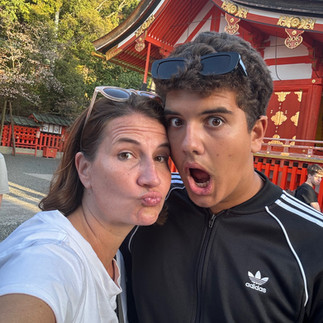Kyoto
- kbeinroth
- Mar 30, 2024
- 2 min read
Day 7
Today was packed with incredible sightseeing at temples, places, and shrines. Our first stop was Nijo-Jo Castle. The castle was completed in 1603 on the orders of Tokugawa Ieyasu, the founder and first Shogun of the Tokugawa Shogunate (1603-1867). Tokugawa Ieyasu unified Japan after a long period of civil war, and ushered in a period of over 260 years of peace and prosperity. During this period, shoguns (Japan's military leaders) held the real power, not the emperors. In 1867 political rule was returned to the emperor, and the Meiji period of imperial rule began.

After visiting Nijo-jo Castle, we went to see the Golden Pavillion. Kinkakuji (金閣寺, Golden Pavilion) is a Zen temple, whose top two floors are completely covered in gold leaf. The temple was the retirement villa of the shogun, Ashikaga Yoshimitsu, and according to his will it became a Zen temple after his death in 1408. The pavilion is surrounded by beautifully manicured garden.
The sun came out and the temperature got warmer - a perfect day to enjoy some matcha ice cream.

Next, we moved on to the Arashiyama Bamboo Forest. Our guide, Akiko, explained that there are over 500 kinds of bamboo in Japan and that it can grow as fast as one meter a day!

We were able to walk around and enjoy lunch in our home. We were excited to enjoy some local
Wagyu beef prepared in the traditional way.

Afterwards, we traveled to Fushimi Inari Shrine to see the thousand Torii Gates⛩️. Shinto is the original religion of Japan. It is a polytheistic and animistic religion, which revolves around supernatural entities called the kami. The kami are believed to inhabit all things. The Torii Gate marks the transition between the mundane and the sacred. The Japanese believe that you become purified with each gate you pas through. the Fushimi Inari Shrine
is famous for its thousands of vermilion gates, and is dedicated to Inari, the Shinto god of rice. Foxes are thought to be Inari's messengers, resulting in many fox statues across the shrine grounds. Fushimi Inari Shrine has ancient origins, predating the capital's move to Kyoto in 794.

Photo by: Jodselyn Rivera
It was a once-in-lifetime experience to walk through this sacred place. Unforgettable!




































Comments